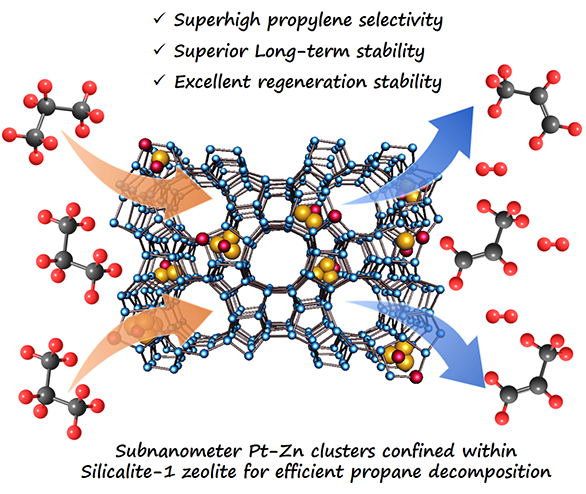Qiming Sun, Ning Wang, Qiyuan Fan, Lei Zeng, Alvaro Mayoral, Shu Miao, Ruoou Yang, Zheng Jiang, Wei Zhou, Jichao Zhang, Tianjun Zhang, Jun Xu, Peng Zhang, Jun Cheng, Dong-Chun Yang, Ran Jia, Lin Li, Qinghong Zhang, Ye Wang,* Osamu Terasaki, and Jihong Yu*. Angew. Chem. Int. Ed.. 2020, DOI:10.1002/anie.202003349 Published 7 April 2020
Propane dehydrogenation (PDH) has great potential to meet the increasing global demand for propylene, but the widely-used Pt-based catalysts usually suffer from short-term stability and unsatisfactory propylene selectivity. In this work, the authors developed a ligand-protected direct hydrogen reduction method for encapsulating subnanometer bimetallic Pt-Zn clusters inside silicalite-1 (S-1) zeolite. The introduction of Zn species significantly improved the stability of the Pt clusters and exhibited a superhigh propylene selectivity of 99.3% with a weight hourly space velocity (WHSV) of 3.6~54 h-1 and specific activity of propylene formation of 65.5 molC3H6 gPt-1 h-1 (WHSV=108 h-1) at 550 °C. Moreover, no obvious deactivation was observed over PtZn4@S-1-H catalyst even after 13000 min on stream (WHSV=3.6 h-1), affording an extremely low deactivation constant of 0.001 h-1, which is 200 times lower than that of the PtZn4/Al2O3 counterpart under the same conditions. Significantly, the introduction of Cs+ ions into the zeolite can improve the regeneration stability of catalysts, and the catalytic activity kept unchanged after four continuous cycles. This work introduces a new strategy for the fabrication of the high-performance catalysts for PDH reaction by encapsulating subnanometer Pt-Zn clusters inside purely siliceous zeolites. The superior catalytic performance and excellent long-term and regeneration stability of PtZn@zeolite catalysts for PDH conversion suggest their significant promise for future industrial applications.

A lean, mean, propylene machine: Subnanometer bimetallic Pt-Zn clusters are encapsulated inside silicalite-1 (S-1) zeolite via a ligand-protected direct hydrogen reduction method, exhibiting excellent activity in the propane dehydrogenation reaction.
This paper reports a remarkable cooperative effort among 10 laboratories in two countries. Prof. Jihong Yu from Jilin University and Prof. Ye Wang form Xianmen University are the co-corresponding authors of the paper. Dr. Qiming Sun and Dr. Ning Wang from Jilin University are the co-first authors of this work. Other co-authors include Ms. Qiyuan Fan, Mr. Lei Zeng, Mr. Wei Zhou, Prof. Jun Chen, and Prof. Qinghong Zhang from Xiamen University, Dr. Alvaro Mayoral and Prof. Osamu Terasaki from ShanghaiTech University, Dr. Shu Miao from JEOL(Beijing) Co., Ltd., Dr. Ruoou Yang, Prof. Zheng Jiang, Jichao Zhang, and Prof. Jun Xu from Chinese Academy of Sciences, Mr. Tianjun Zhang, Mr. Dong-Chun Yang, Prof. Ran Jia, and Dr. Lin Li from Jilin University, and Prof. Peng Zhang from Dalhousie University.
Read more at Angew. Chem. Int. Ed.:
https://onlinelibrary.wiley.com/doi/abs/10.1002/anie.202003349
The paper was highlighted by Wechat media platform:
https://wemp.app/posts/f149ba1c-4c72-4da0-9df7-e1b67e187cf0
http://m.nanoer.net/column/view?id=17566
https://mp.weixin.qq.com/s/EytwKQvbJ30kp4lLK8Y3LA
https://www.x-mol.com/news/451549